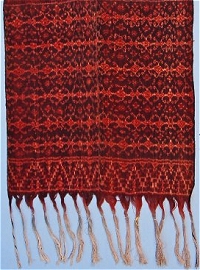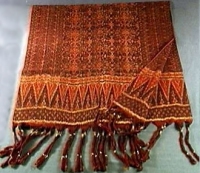 |

IKAT FROM ENDE, INDONESIA
GALLERY 

- 161 ENDE
Semba (man's shawl). Warp ikat. 1910-1930. Probably Ende proper.
- 190 ENDE
Zawo (sarong). Weft ikat. Circa 1850 (well before 1888)
- 196 ENDE
Zawo (sarong). Warp ikat. Circa 1930. Village unknown.
- 199 ENDE
Semba (man's shawl). Weft ikat. 19th - early 20th c. �.
- 233 ENDE
Zawo (sarong). Warp ikat. 1940 or before. Village unknown, but probably Ende proper.
- 238 ENDE
Semba (man's shawl). Warp ikat. 19th or early 20th c. (before 1930). Ende proper most likely,given the design's sophistication.
- 239 ENDE
Semba (man's shawl). Warp ikat. 19th or early 20th c. (before 1930). Ende proper, most likely, given the stature of the man for whom this was intended. .
- 246 ENDE
Semba (man's shawl). Warp ikat. 1910-1930
- 251 ENDE
Semba (men's shawl). Warp ikat. Before 1950. Identification requires further research.
- 259 ENDE
Zawo (sarong). Warp ikat. 1910-1930. Probably Ende proper.
Ende - a coastal region open to foreign influence

|

|
|
Ende man's wrap. British Museum. Probably mid to late 20th C. Note the absence of lateral borders.
|
In colonial days, Ende, on Flores's southern coast, was one of the main ports through which imports and exports flowed - including the patola tradecloths that the Dutch employed to buy the loyalty of local rulers. As a result, imitation of these 'royal' textiles dominates the style of the region, as it does in neighbouring Ndona and Lio, with which they are easy to confuse.
At the risk of being overly subjective, one could say that those from Ndona and Lio, while very similar, are more beautiful - better organized overall design, exquisite execution, subtler colouration, in other words more chic. Which explains why they are better represented in our collection.
Ende sarongs can be distinguished from their Lio counterparts by the black bands, called mita mere, that separate the midfield, ora, from the endfields, called singi. The red-brown of Lio cloths tends to be darker, close to russett or the colour of eggplant, whereas Ende cloths are usually redder.
Animal motifs are sometimes used in Ende, but only stylized - often to the point of disguise, as Islam, which forbids the depiction of living beings, was established in this coastal region as early as the mid 17th C. when Muslim Macassarese seafarers began dominating the area, intermingling with the original inhabitants. The horse motif is, or rather was, the prerogative of the nobility. According to Khan-Majlis, it could not be used at weddings, and at funerals sarongs decorated with horses could only be worn upside down.
Ende sarongs
Ende sarongs show an almost endless variety in overall design and motif, all of them known by specific names, which, as Hamilton remarks, "might be expected to provide the foundation for an extensive vocabulary of social meaning". This is not the case, however. Modern day Ende women no longer care for patterns that radiate status, and prefer class-neutral designs: sarongs of similar material and workmanship are rated equally.
As morinda red is considered more classy than indigo in the wider region, presumably this used to be the case in Ende as well, but perhaps the almost cosmopolitan effect of Ende's role as a port town had erased such distinctions early, in the first decades of the 20th C.
The sarongs are always made of three panels, the end panels being mirror images of each other. The central panel may have vertical side borders, repeated once or multiple times in the midfield, dividing it into vertical sections.
Hamilton distinguishes three types of Ende sarong, based on the treatment of the midfield:
- Zawo khabi, the most traditional. Marked by an undivided midfield, khabi, meaning whole, undivided. Colours and white and morinda red on purple-black (morinda and indigo overdyed) background. The type has various subtypes, named depending on the motif, e.g. nggaja (elephant), jara (horse), pea (bird?). They are free of class associations, and all are suitable as bridewealth.
- Zawo mangga, field consists of a varying number of ikat bands and stripes, black bands separating midfield from endfields. Colours are white on indigo background, with accent stripes in red. Also has several names subtypes.
- Zawo ngera or zawo gezo, similar to zawo mangga, but colours are red and white on black background.
Ende man's wraps

|

|
|
Ende style man's cloth, semba, in the old style, very closely imitating patola, including lateral borders, dating from before 1890. Collection Rijksmuseum Volkenkunde in Leiden.
|
Ende man's wraps, two-panel cloths called semba, used to imitate patola very closely, but around 1930 they became somewhat simplified, as the lateral borders were dropped, while in Ndona (where the patola pattern was introduced by brides from Ende) the classical pattern survives to the current day. Ende semba used to accompany their wearers into the grave, which helps explain their rarity - except in museum collections, where they are well represented, though the archaic type is a rarity there too.
Around 1925, a time when colonial administrators began buying Indonesian cloths to decorate their homes, Endenese weavers, inspired by commercial opportunity, began imitating Sumba hinggi, borrowing its visually appealing vernacular of animal and anthropomorphic motifs, even its skull-trees. The semba stopped being made after the end of World War II when Florenese men adopted western dress, though single panel shawls, sa nai, with motifs similar to those on sarongs, continue to be made.
|
Literature
The best literature on Ende ikat textiles that we have found so far is Roy Hamilton's chapter on the Ende Regency in his Gift of the Cotton Maiden.
Map showing Ende Regency on Flores

©Peter ten Hoopen, 2025. The contents of this website are provided for personal, educational, non-commercial use only.
No part of this website may be reproduced in any form without explicit permission of the copyright holder.
|  |




